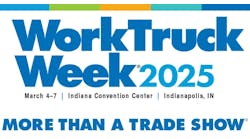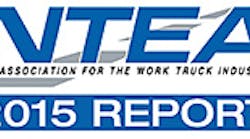A company that increases its sales by 2% more than it increases payroll for five straight years can take its profit from $300,000 to $784,400, according to Albert Bates, founder of the Profit Planning Group.
“Let me tell you this: It’s hard to do,” he said. “It’s easier to do from this side of podium than that side. But you can do it.”
In his presentation, “By the Numbers: Metrics for Management,” Bates said his goal is to make a company’s bottom line twice as big as it currently is. To illustrate it, he presented the financial results for Mountain View Inc, a fictitious $10 million company but one he says is a typical National Truck Equipment Association (NTEA) member (based on an annual survey), with half of the companies doing better and half doing worse.
Mountain View has a cost of goods of $7.8 million for a gross margin of $2.2 million, which he says is “too low. We need to make the gross margin larger.”
Payroll and fringes account for $1.25 million and all other expenses for $650,000, making total expenses $1.9 million.
“Payroll overwhelms everything else,” he said. “We are a people business. But payroll is too high. We are trying to get the margin up and payroll down. Over time, we want to get payroll under control. Profit before taxes is $300,000. We want to turn that 3% to 6%.
“On the same sales volume, I want to make $600,000 instead of $300,000. We do that by looking at the results of the survey. The high-profit companies tend to have a better gross margin.
“We want to get to a 6% bottom line in five years. Many of you are sitting there saying, ‘Five years is too long.’ That’s fine. If you want to do it quicker, give it a shot. Do not, however, tell me you’re going to do it on one year. There are a lot of one-year plans out there that are going to suddenly change the business and make it twice as profitable in one year. A one-year plan is great, but it has one problem: It doesn’t work. The reason I know that is because if you tell me, ‘I’m going to go from 3% to 6% in one year,’ I’ll say, ‘If it was that easy, anybody could do it. If it was just lying on the ground, waiting to be picked up, I think you would have already made 6%.’ ”
There are various ways to get from 3% to 6%:
• A sales increase of 25%.
“As your sales go up, your gross margin is 22% of a bigger number. The fixed expenses stay the same, but the variable expenses go up because you’ve got more sales commissions, bad debts, and more interest on financing.”
• A decrease in expenses of 17%.
“Cutting expenses actually puts profit on the bottom line faster than raising sales. That’s terrible because there’s nobody in the room who got up this morning and said, ‘It’s a beautiful day. I’m going to cut expenses.’ You’re all saying you want to increase your sales. It’s dynamic, it’s going forward. Expense control is going backwards and having unpleasant conversations. It’s vile, filthy, and disgusting. But it has one little benefit: It drives profit to your bottom line like nothing on the face of the earth. If we’re going to suggest that expense decrease is a critical factor, I have to deal with the payroll side of the business. We can’t say, ‘I’m going to turn off the lights.’ I have to deal with payroll, and it’s going to be difficult to do.”
• A gross margin increase of 15%.
“Gross margin actually has a quicker impact on the bottom line than does expense control. Expense control and gross margin are absolutely the keys to life. That’s a brutal message because we’d like to say, ‘Why don’t we just sell our way to success?’ But the reality is, sales growth provides a vehicle that probably makes it a little easier to get control of margin and expenses, but it doesn’t solve the problem.”
Bates said the typical NTEA companies have similar, but not identical, economics.
He said executives typically hear his presentations and go back to their companies, but get immersed in the minutiae of the day. To simplify it, he recommends thinking that gross margin is the #1 concern, followed by expense control, sales, and inventory and accounts receivable.
To determine how much of each, he said a good starting plan is his “Improvement Model: A Rack-Suit Plan.”
“We’re going to go to Men’s Warehouse and buy a suit that fits everybody in the room,” he said. “So buy a rack suit and everybody suits it to their situation.”
There are four parts to it:
• Increasing sales by at least the inflation rate (2%), plus the safety factor (3%), for a total of 5%.
“Right now, the economy is good, and that might be an easy go. But at times, it gets a little bit more difficult. This is an absolute minimum. It’s not a maximum. This is good as long as the inflation rate stays the same. I need sales to go north. You cannot have them going south. For those of you old enough to remember those wonderful years in the late 1970s, the inflation rate was 18%. Eighteen plus three is 21. Luckily, Jimmy Carter is not running for re-election. That’s a goal for everybody. It’s not a rack suit goal.”
• Forcing payroll to increase by 2% less than sales. “However fast your sales increases in your business, I want payroll to go up 2% slower. If sales are up 5%, payroll can only go up by 3%. This is something every firm needs to do. This is for everybody. This is not a rack suit. It’s a tailored suit. This should be on your list of things to do. People want their salary to go up. And that’s OK as long as sales are growing faster than payroll. You might say, ‘That’s a dumb thing. Anybody can do that.’ We’ve been doing this survey since the Dark Ages. I like to go back 20 years ago, and I ask myself, ‘What was payroll as a percentage of sales in this industry? What is it right now?’ Right now, it’s 12.5%. Twenty years ago, it was 12.5%. We have grown, gotten bigger, smarter, and better, but for reasons not necessarily our fault, we have not gotten control of payroll as a percentage of revenue. I need you to get control of that. It’s not optional. It is the single most difficult challenge we will face because healthcare costs are going north. I’ve got a lot of pressure right now on wages. You ain’t done it in 20 years, so don’t tell me, ‘Piece of cake.’ ”
• Increasing the gross margin percentage by 0.2%. “It’s not the gross margin dollars. It’s gross margin percentage. That’s 22% for this company. We want to take it to 22.2%. I’m going to do it by pricing and buying and a lot of things involved in that process. This is not easy, but it’s achievable attainable, doable—all sorts of buzzwords for ‘hard.’ ”
• Decreasing the other expense percentage by 0.2%. “Of all the things on the chart, this is the easiest. None of them are easy. But if we can do #1, in which sales go north every year, systematically the other expenses as a percentage of sales will tend to fall.”
His plan for controlling payroll without sacrificing employee enthusiasm (“well, maybe a little,” he adds) is building a 2% sales-growth-to-payroll-growth gap. If the sales growth is 5%, the payroll growth is 3%.
“This is crucial,” he said. “It is the most difficult thing you will try to do, by far. I don’t care how fast the sales grow as long as it’s 2% faster than payroll growth. You don’t need the sales growth to be highly profitable.”
Under 5% sales growth, his absolute minimum, sales go from $10 million to $10.5 million. Payroll goes up by 3% to $1,287,500. Gross margin goes to $2,310,000.
Under 15% sales growth with a 2% sales-to-payroll wedge, sales go to $11.5 million, payroll to $1,412,500, gross margin to $2,530,000, and the bottom line profit is $300,000.
“I refer to it as, ‘Let the good times roll,’ ” he said. “That says that if you can drive the sales up 15%, you can let payroll go up a lot. You can hire more people. That’s what sales growth does for you. I can let the payroll go up 13%. The bottom-line profit is $370,000.
“I’m going to suggest that sales volume by itself doesn’t mean doodly-squat. It ain’t the sales. It’s, how much payroll do you have to spend to generate those sales?
“The problem is Fred. He’s been with you 20 years—and stopped working 18 years ago. He’s a nice guy. But he’s just not producing. When you have a non-producer, this gap between sales growth and payroll can go backwards.”
The attack points in driving a sales-to-payroll wedge:
• Controlling—maybe eliminating—the problem portion of the sales force.
“You’ve got some sales people who are wonderful. You’ve got some sales people who are Fred.”
• Fundamentally altering order economics.
“Productivity improvements will set you free. Distributors have gotten much more sophisticated in recent years, with bar coding, fleet scheduling, activity-based costing, Internet sales, supply-chain management, and RFID technology.
“Here’s the problem: Technology won’t solve the problem. Technology will help you solve the problem. If you do not involve technology, you will get farther and farther behind. The fact that you do it will only keep you up with everybody else.”
• Working with the customer set to change behavior.
It’s important to consider profitability in relation to workload, he said.
“What is mega-important is raising the average line value,” he said. “I have to make the average transaction the bigger number. That will get me to raising prices.
“I also have to stop selling to jerks. You’ve got some customers who are wonderful and some customers who are terrible.
“I take my customers and put them into four categories—not based on how much they buy, but how profitable they are to you.
“I have 15% of my customers that are wonderful. We make 100% of our profit on them. I have another 15% on which I make 35% of my profit, and 35% on which I make 10%, but on the final 35% of them, I lose 45%. It’s a really interesting relationship. We need to do something to the bottom guys and rethink our relationship.
“There are two strategies. One is to fire them. I am not a ‘fire them’ guy. But there is probably about 2% of your customers you should fire. You’ve got to fire them the right way. You can’t say, ‘I’ve never liked you.’ I’ve got to fire them gently. The best way is to let them fire themselves. Raise prices until maybe they go away.
“Or I have to get them to buy in different ways and not tie up my sales force, and not have so many special situations all the time. That’s a lot of work.”
He said companies must plan payroll in relationship to sales. Sales have to go up 2% faster than payroll.
He said the most global way of improving the gross margin percentage is by either buying it cheaper or selling it higher:
• Buy cheaper.
“In the current model, sales volume is $10 million. But I’m going to buy it cheaper so the gross margin is 22.5%, not 22%. I have to find a way to buy it $50,000 cheaper. I have to negotiate it as well as I can. My bottom line becomes $350,000.”
• Raise prices.
“So that I now have sales of $10,064,506. I went back to the cost of goods: $7.8 million. I want my gross margin to be 22.5%. My profit becomes $361,290.”
He said “buying cheaper is nifty, but selling it higher is niftier.” ♦










